Electronic Devices and Circuits Project: Smart Home using Arduino
VerifiedAdded on 2022/10/14
|7
|2121
|19
Project
AI Summary
This project report details the design and implementation of a Smart Home system using an Arduino microcontroller. The system incorporates various components, including servo motors for door control, a 4-channel relay for controlling LED bulbs, and a Bluetooth module for remote control via an Android device. An LCD displays temperature and humidity readings from a DH11 sensor, and an RC car adds an automated touch to the model. The report provides detailed descriptions of each component, including the Arduino UNO, LCD (JHD 1602A), relay module, DC servo motor (SG90), DC motor, Bluetooth module (HC05), motor driver (L298N), DH11 module, and battery. The working of the circuit involves the Bluetooth module linked to a relay module, which acts as a switch for the external circuit based on user signals sent via Bluetooth. The conclusion highlights the prototype's capability to control common home appliances, with potential for future enhancements to meet user needs. The project aims to create awareness about home automation and its role in a smart world.
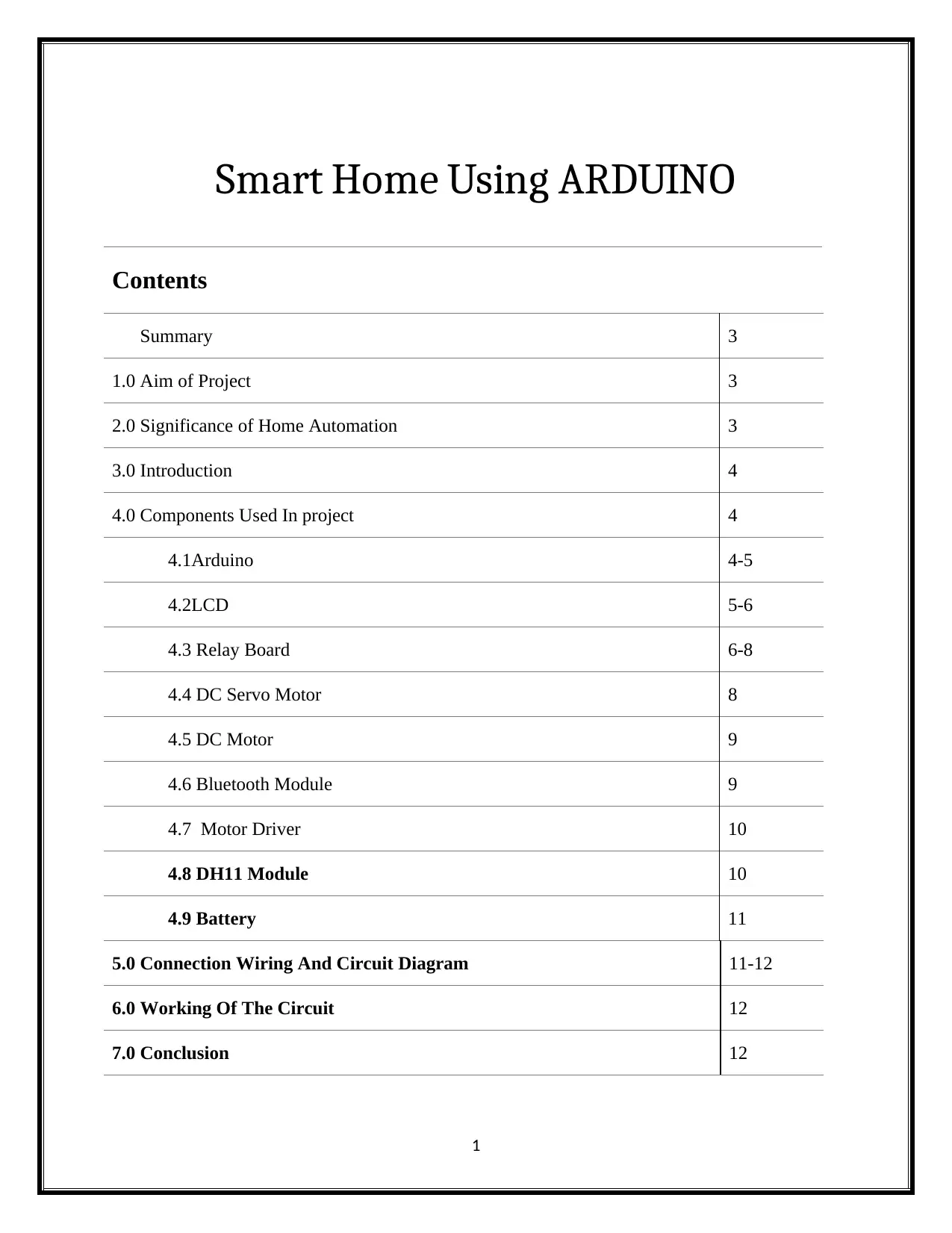
Smart Home Using ARDUINO
Contents
Summary 3
1.0 Aim of Project 3
2.0 Significance of Home Automation 3
3.0 Introduction 4
4.0 Components Used In project 4
4.1Arduino 4-5
4.2LCD 5-6
4.3 Relay Board 6-8
4.4 DC Servo Motor 8
4.5 DC Motor 9
4.6 Bluetooth Module 9
4.7 Motor Driver 10
4.8 DH11 Module 10
4.9 Battery 11
5.0 Connection Wiring And Circuit Diagram 11-12
6.0 Working Of The Circuit 12
7.0 Conclusion 12
1
Contents
Summary 3
1.0 Aim of Project 3
2.0 Significance of Home Automation 3
3.0 Introduction 4
4.0 Components Used In project 4
4.1Arduino 4-5
4.2LCD 5-6
4.3 Relay Board 6-8
4.4 DC Servo Motor 8
4.5 DC Motor 9
4.6 Bluetooth Module 9
4.7 Motor Driver 10
4.8 DH11 Module 10
4.9 Battery 11
5.0 Connection Wiring And Circuit Diagram 11-12
6.0 Working Of The Circuit 12
7.0 Conclusion 12
1
Paraphrase This Document
Need a fresh take? Get an instant paraphrase of this document with our AI Paraphraser
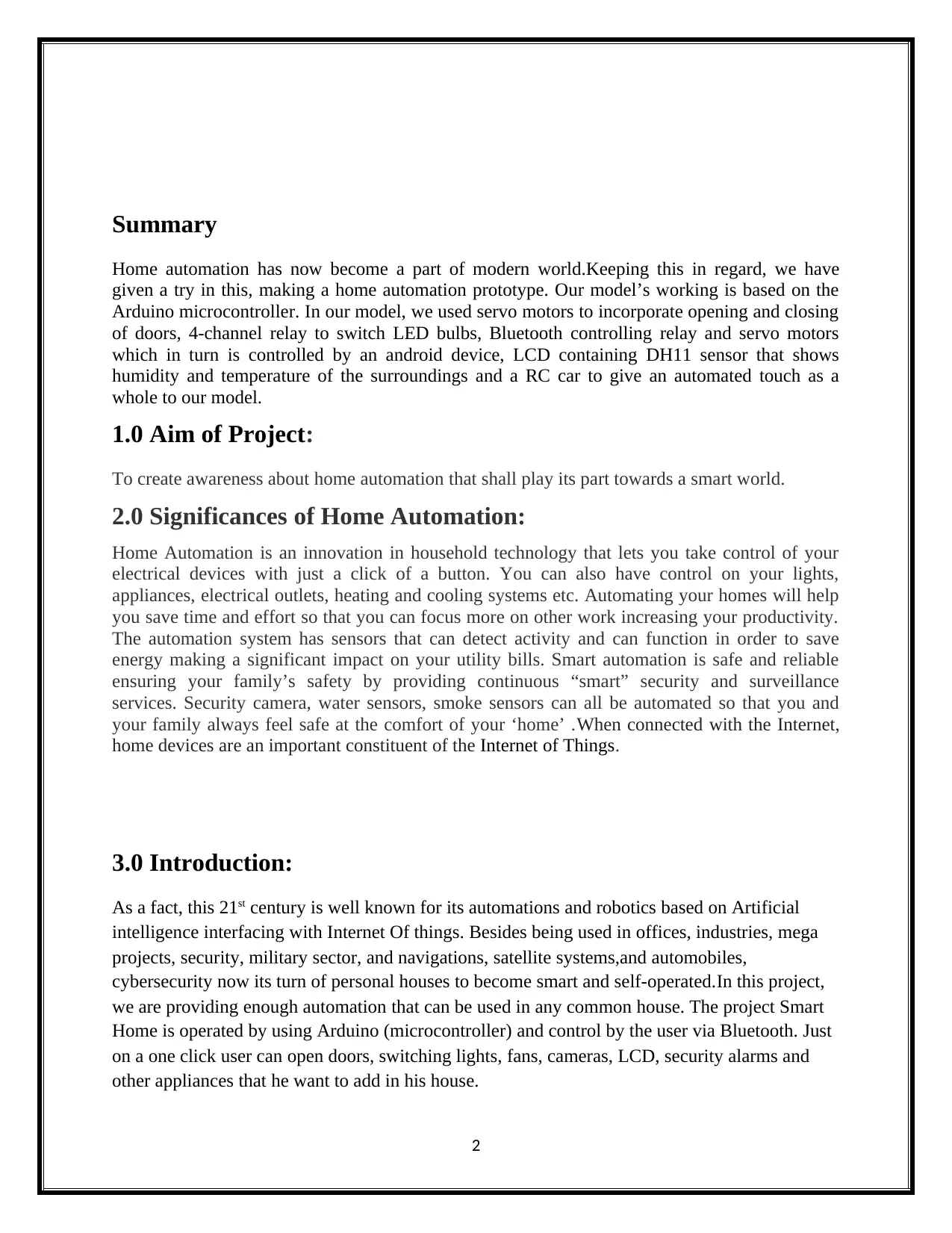
Summary
Home automation has now become a part of modern world.Keeping this in regard, we have
given a try in this, making a home automation prototype. Our model’s working is based on the
Arduino microcontroller. In our model, we used servo motors to incorporate opening and closing
of doors, 4-channel relay to switch LED bulbs, Bluetooth controlling relay and servo motors
which in turn is controlled by an android device, LCD containing DH11 sensor that shows
humidity and temperature of the surroundings and a RC car to give an automated touch as a
whole to our model.
1.0 Aim of Project:
To create awareness about home automation that shall play its part towards a smart world.
2.0 Significances of Home Automation:
Home Automation is an innovation in household technology that lets you take control of your
electrical devices with just a click of a button. You can also have control on your lights,
appliances, electrical outlets, heating and cooling systems etc. Automating your homes will help
you save time and effort so that you can focus more on other work increasing your productivity.
The automation system has sensors that can detect activity and can function in order to save
energy making a significant impact on your utility bills. Smart automation is safe and reliable
ensuring your family’s safety by providing continuous “smart” security and surveillance
services. Security camera, water sensors, smoke sensors can all be automated so that you and
your family always feel safe at the comfort of your ‘home’ .When connected with the Internet,
home devices are an important constituent of the Internet of Things.
3.0 Introduction:
As a fact, this 21st century is well known for its automations and robotics based on Artificial
intelligence interfacing with Internet Of things. Besides being used in offices, industries, mega
projects, security, military sector, and navigations, satellite systems,and automobiles,
cybersecurity now its turn of personal houses to become smart and self-operated.In this project,
we are providing enough automation that can be used in any common house. The project Smart
Home is operated by using Arduino (microcontroller) and control by the user via Bluetooth. Just
on a one click user can open doors, switching lights, fans, cameras, LCD, security alarms and
other appliances that he want to add in his house.
2
Home automation has now become a part of modern world.Keeping this in regard, we have
given a try in this, making a home automation prototype. Our model’s working is based on the
Arduino microcontroller. In our model, we used servo motors to incorporate opening and closing
of doors, 4-channel relay to switch LED bulbs, Bluetooth controlling relay and servo motors
which in turn is controlled by an android device, LCD containing DH11 sensor that shows
humidity and temperature of the surroundings and a RC car to give an automated touch as a
whole to our model.
1.0 Aim of Project:
To create awareness about home automation that shall play its part towards a smart world.
2.0 Significances of Home Automation:
Home Automation is an innovation in household technology that lets you take control of your
electrical devices with just a click of a button. You can also have control on your lights,
appliances, electrical outlets, heating and cooling systems etc. Automating your homes will help
you save time and effort so that you can focus more on other work increasing your productivity.
The automation system has sensors that can detect activity and can function in order to save
energy making a significant impact on your utility bills. Smart automation is safe and reliable
ensuring your family’s safety by providing continuous “smart” security and surveillance
services. Security camera, water sensors, smoke sensors can all be automated so that you and
your family always feel safe at the comfort of your ‘home’ .When connected with the Internet,
home devices are an important constituent of the Internet of Things.
3.0 Introduction:
As a fact, this 21st century is well known for its automations and robotics based on Artificial
intelligence interfacing with Internet Of things. Besides being used in offices, industries, mega
projects, security, military sector, and navigations, satellite systems,and automobiles,
cybersecurity now its turn of personal houses to become smart and self-operated.In this project,
we are providing enough automation that can be used in any common house. The project Smart
Home is operated by using Arduino (microcontroller) and control by the user via Bluetooth. Just
on a one click user can open doors, switching lights, fans, cameras, LCD, security alarms and
other appliances that he want to add in his house.
2
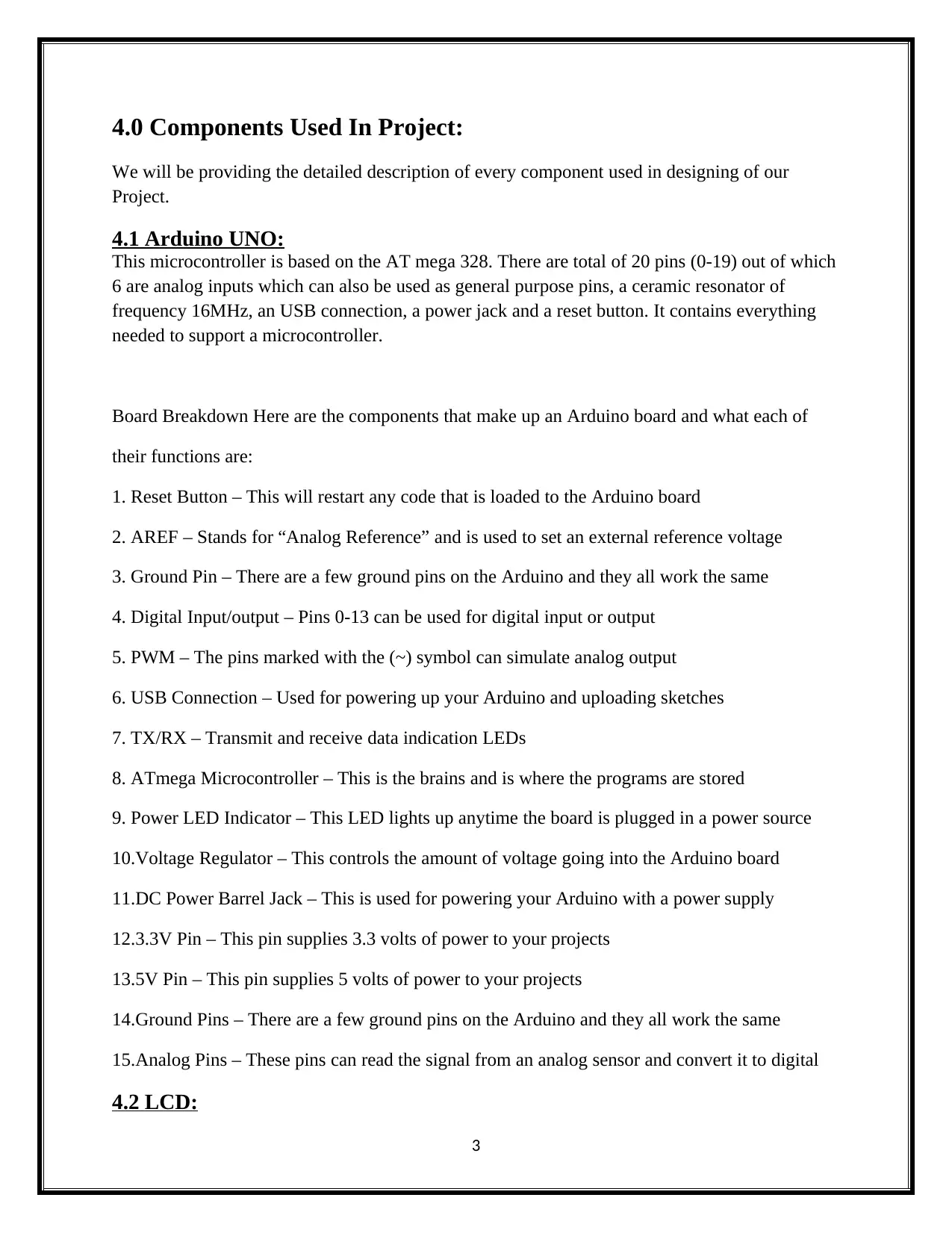
4.0 Components Used In Project:
We will be providing the detailed description of every component used in designing of our
Project.
4.1 Arduino UNO:
This microcontroller is based on the AT mega 328. There are total of 20 pins (0-19) out of which
6 are analog inputs which can also be used as general purpose pins, a ceramic resonator of
frequency 16MHz, an USB connection, a power jack and a reset button. It contains everything
needed to support a microcontroller.
Board Breakdown Here are the components that make up an Arduino board and what each of
their functions are:
1. Reset Button – This will restart any code that is loaded to the Arduino board
2. AREF – Stands for “Analog Reference” and is used to set an external reference voltage
3. Ground Pin – There are a few ground pins on the Arduino and they all work the same
4. Digital Input/output – Pins 0-13 can be used for digital input or output
5. PWM – The pins marked with the (~) symbol can simulate analog output
6. USB Connection – Used for powering up your Arduino and uploading sketches
7. TX/RX – Transmit and receive data indication LEDs
8. ATmega Microcontroller – This is the brains and is where the programs are stored
9. Power LED Indicator – This LED lights up anytime the board is plugged in a power source
10.Voltage Regulator – This controls the amount of voltage going into the Arduino board
11.DC Power Barrel Jack – This is used for powering your Arduino with a power supply
12.3.3V Pin – This pin supplies 3.3 volts of power to your projects
13.5V Pin – This pin supplies 5 volts of power to your projects
14.Ground Pins – There are a few ground pins on the Arduino and they all work the same
15.Analog Pins – These pins can read the signal from an analog sensor and convert it to digital
4.2 LCD:
3
We will be providing the detailed description of every component used in designing of our
Project.
4.1 Arduino UNO:
This microcontroller is based on the AT mega 328. There are total of 20 pins (0-19) out of which
6 are analog inputs which can also be used as general purpose pins, a ceramic resonator of
frequency 16MHz, an USB connection, a power jack and a reset button. It contains everything
needed to support a microcontroller.
Board Breakdown Here are the components that make up an Arduino board and what each of
their functions are:
1. Reset Button – This will restart any code that is loaded to the Arduino board
2. AREF – Stands for “Analog Reference” and is used to set an external reference voltage
3. Ground Pin – There are a few ground pins on the Arduino and they all work the same
4. Digital Input/output – Pins 0-13 can be used for digital input or output
5. PWM – The pins marked with the (~) symbol can simulate analog output
6. USB Connection – Used for powering up your Arduino and uploading sketches
7. TX/RX – Transmit and receive data indication LEDs
8. ATmega Microcontroller – This is the brains and is where the programs are stored
9. Power LED Indicator – This LED lights up anytime the board is plugged in a power source
10.Voltage Regulator – This controls the amount of voltage going into the Arduino board
11.DC Power Barrel Jack – This is used for powering your Arduino with a power supply
12.3.3V Pin – This pin supplies 3.3 volts of power to your projects
13.5V Pin – This pin supplies 5 volts of power to your projects
14.Ground Pins – There are a few ground pins on the Arduino and they all work the same
15.Analog Pins – These pins can read the signal from an analog sensor and convert it to digital
4.2 LCD:
3
⊘ This is a preview!⊘
Do you want full access?
Subscribe today to unlock all pages.

Trusted by 1+ million students worldwide
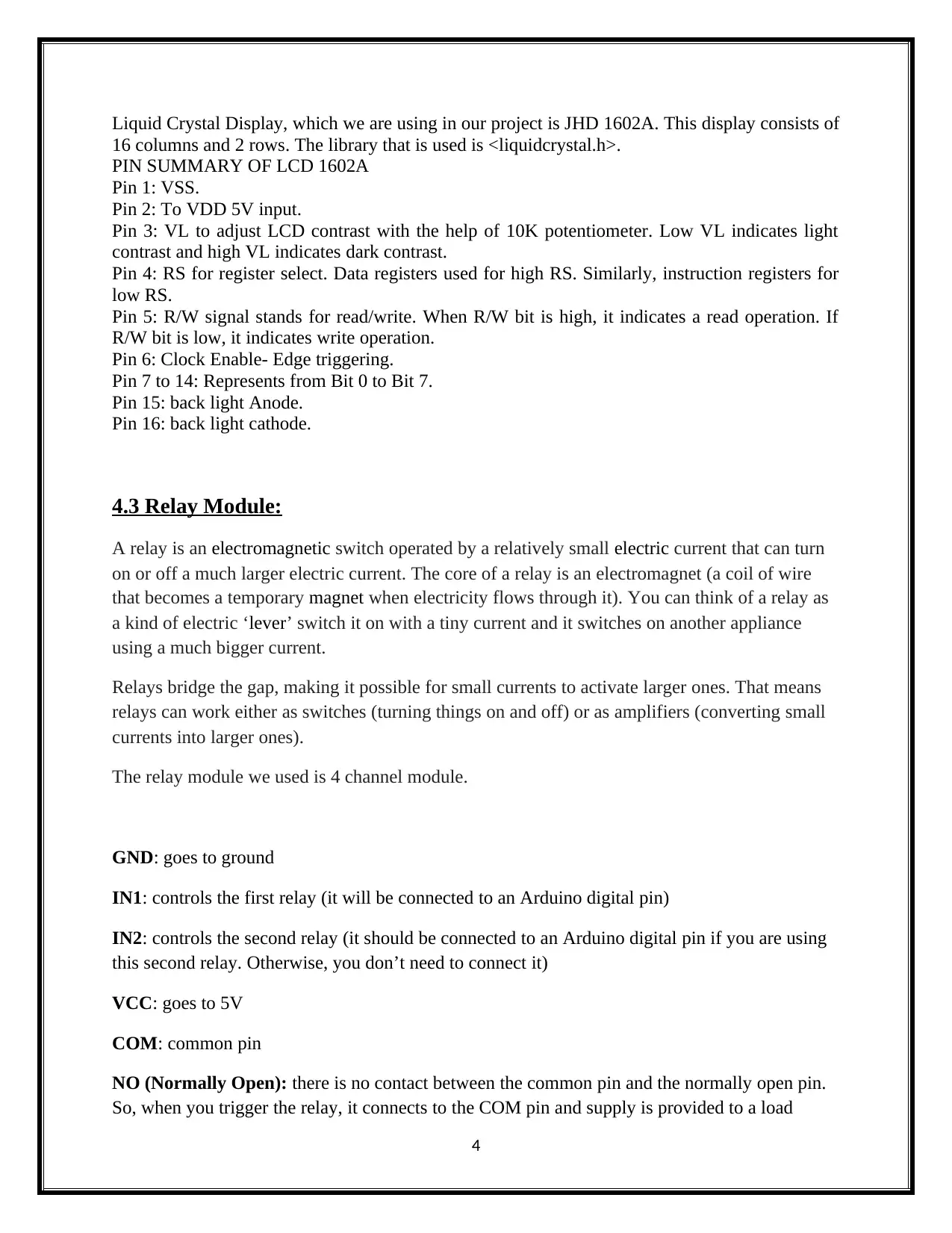
Liquid Crystal Display, which we are using in our project is JHD 1602A. This display consists of
16 columns and 2 rows. The library that is used is <liquidcrystal.h>.
PIN SUMMARY OF LCD 1602A
Pin 1: VSS.
Pin 2: To VDD 5V input.
Pin 3: VL to adjust LCD contrast with the help of 10K potentiometer. Low VL indicates light
contrast and high VL indicates dark contrast.
Pin 4: RS for register select. Data registers used for high RS. Similarly, instruction registers for
low RS.
Pin 5: R/W signal stands for read/write. When R/W bit is high, it indicates a read operation. If
R/W bit is low, it indicates write operation.
Pin 6: Clock Enable- Edge triggering.
Pin 7 to 14: Represents from Bit 0 to Bit 7.
Pin 15: back light Anode.
Pin 16: back light cathode.
4.3 Relay Module:
A relay is an electromagnetic switch operated by a relatively small electric current that can turn
on or off a much larger electric current. The core of a relay is an electromagnet (a coil of wire
that becomes a temporary magnet when electricity flows through it). You can think of a relay as
a kind of electric ‘lever’ switch it on with a tiny current and it switches on another appliance
using a much bigger current.
Relays bridge the gap, making it possible for small currents to activate larger ones. That means
relays can work either as switches (turning things on and off) or as amplifiers (converting small
currents into larger ones).
The relay module we used is 4 channel module.
GND: goes to ground
IN1: controls the first relay (it will be connected to an Arduino digital pin)
IN2: controls the second relay (it should be connected to an Arduino digital pin if you are using
this second relay. Otherwise, you don’t need to connect it)
VCC: goes to 5V
COM: common pin
NO (Normally Open): there is no contact between the common pin and the normally open pin.
So, when you trigger the relay, it connects to the COM pin and supply is provided to a load
4
16 columns and 2 rows. The library that is used is <liquidcrystal.h>.
PIN SUMMARY OF LCD 1602A
Pin 1: VSS.
Pin 2: To VDD 5V input.
Pin 3: VL to adjust LCD contrast with the help of 10K potentiometer. Low VL indicates light
contrast and high VL indicates dark contrast.
Pin 4: RS for register select. Data registers used for high RS. Similarly, instruction registers for
low RS.
Pin 5: R/W signal stands for read/write. When R/W bit is high, it indicates a read operation. If
R/W bit is low, it indicates write operation.
Pin 6: Clock Enable- Edge triggering.
Pin 7 to 14: Represents from Bit 0 to Bit 7.
Pin 15: back light Anode.
Pin 16: back light cathode.
4.3 Relay Module:
A relay is an electromagnetic switch operated by a relatively small electric current that can turn
on or off a much larger electric current. The core of a relay is an electromagnet (a coil of wire
that becomes a temporary magnet when electricity flows through it). You can think of a relay as
a kind of electric ‘lever’ switch it on with a tiny current and it switches on another appliance
using a much bigger current.
Relays bridge the gap, making it possible for small currents to activate larger ones. That means
relays can work either as switches (turning things on and off) or as amplifiers (converting small
currents into larger ones).
The relay module we used is 4 channel module.
GND: goes to ground
IN1: controls the first relay (it will be connected to an Arduino digital pin)
IN2: controls the second relay (it should be connected to an Arduino digital pin if you are using
this second relay. Otherwise, you don’t need to connect it)
VCC: goes to 5V
COM: common pin
NO (Normally Open): there is no contact between the common pin and the normally open pin.
So, when you trigger the relay, it connects to the COM pin and supply is provided to a load
4
Paraphrase This Document
Need a fresh take? Get an instant paraphrase of this document with our AI Paraphraser
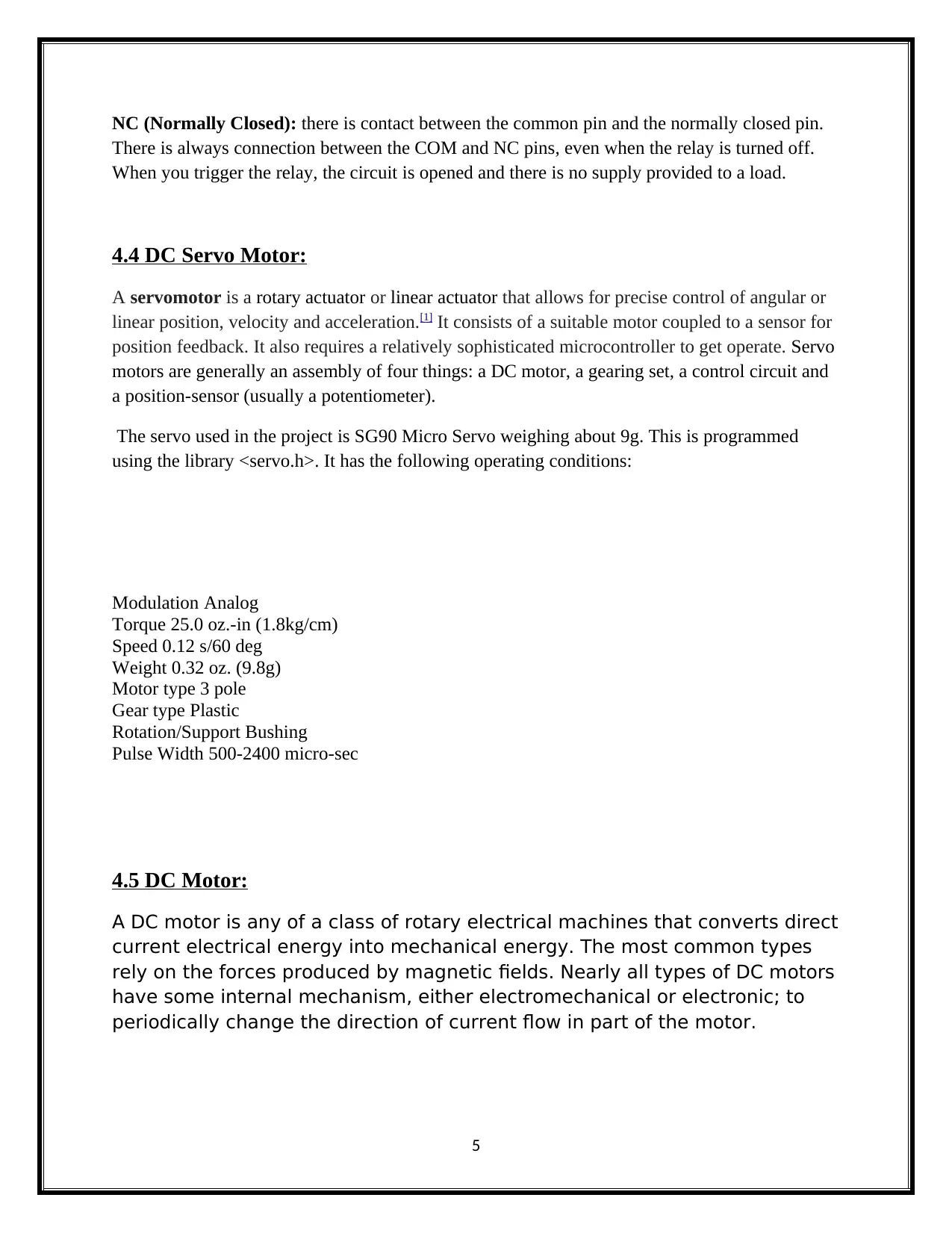
NC (Normally Closed): there is contact between the common pin and the normally closed pin.
There is always connection between the COM and NC pins, even when the relay is turned off.
When you trigger the relay, the circuit is opened and there is no supply provided to a load.
4.4 DC Servo Motor:
A servomotor is a rotary actuator or linear actuator that allows for precise control of angular or
linear position, velocity and acceleration.[1] It consists of a suitable motor coupled to a sensor for
position feedback. It also requires a relatively sophisticated microcontroller to get operate. Servo
motors are generally an assembly of four things: a DC motor, a gearing set, a control circuit and
a position-sensor (usually a potentiometer).
The servo used in the project is SG90 Micro Servo weighing about 9g. This is programmed
using the library <servo.h>. It has the following operating conditions:
Modulation Analog
Torque 25.0 oz.-in (1.8kg/cm)
Speed 0.12 s/60 deg
Weight 0.32 oz. (9.8g)
Motor type 3 pole
Gear type Plastic
Rotation/Support Bushing
Pulse Width 500-2400 micro-sec
4.5 DC Motor:
A DC motor is any of a class of rotary electrical machines that converts direct
current electrical energy into mechanical energy. The most common types
rely on the forces produced by magnetic fields. Nearly all types of DC motors
have some internal mechanism, either electromechanical or electronic; to
periodically change the direction of current flow in part of the motor.
5
There is always connection between the COM and NC pins, even when the relay is turned off.
When you trigger the relay, the circuit is opened and there is no supply provided to a load.
4.4 DC Servo Motor:
A servomotor is a rotary actuator or linear actuator that allows for precise control of angular or
linear position, velocity and acceleration.[1] It consists of a suitable motor coupled to a sensor for
position feedback. It also requires a relatively sophisticated microcontroller to get operate. Servo
motors are generally an assembly of four things: a DC motor, a gearing set, a control circuit and
a position-sensor (usually a potentiometer).
The servo used in the project is SG90 Micro Servo weighing about 9g. This is programmed
using the library <servo.h>. It has the following operating conditions:
Modulation Analog
Torque 25.0 oz.-in (1.8kg/cm)
Speed 0.12 s/60 deg
Weight 0.32 oz. (9.8g)
Motor type 3 pole
Gear type Plastic
Rotation/Support Bushing
Pulse Width 500-2400 micro-sec
4.5 DC Motor:
A DC motor is any of a class of rotary electrical machines that converts direct
current electrical energy into mechanical energy. The most common types
rely on the forces produced by magnetic fields. Nearly all types of DC motors
have some internal mechanism, either electromechanical or electronic; to
periodically change the direction of current flow in part of the motor.
5
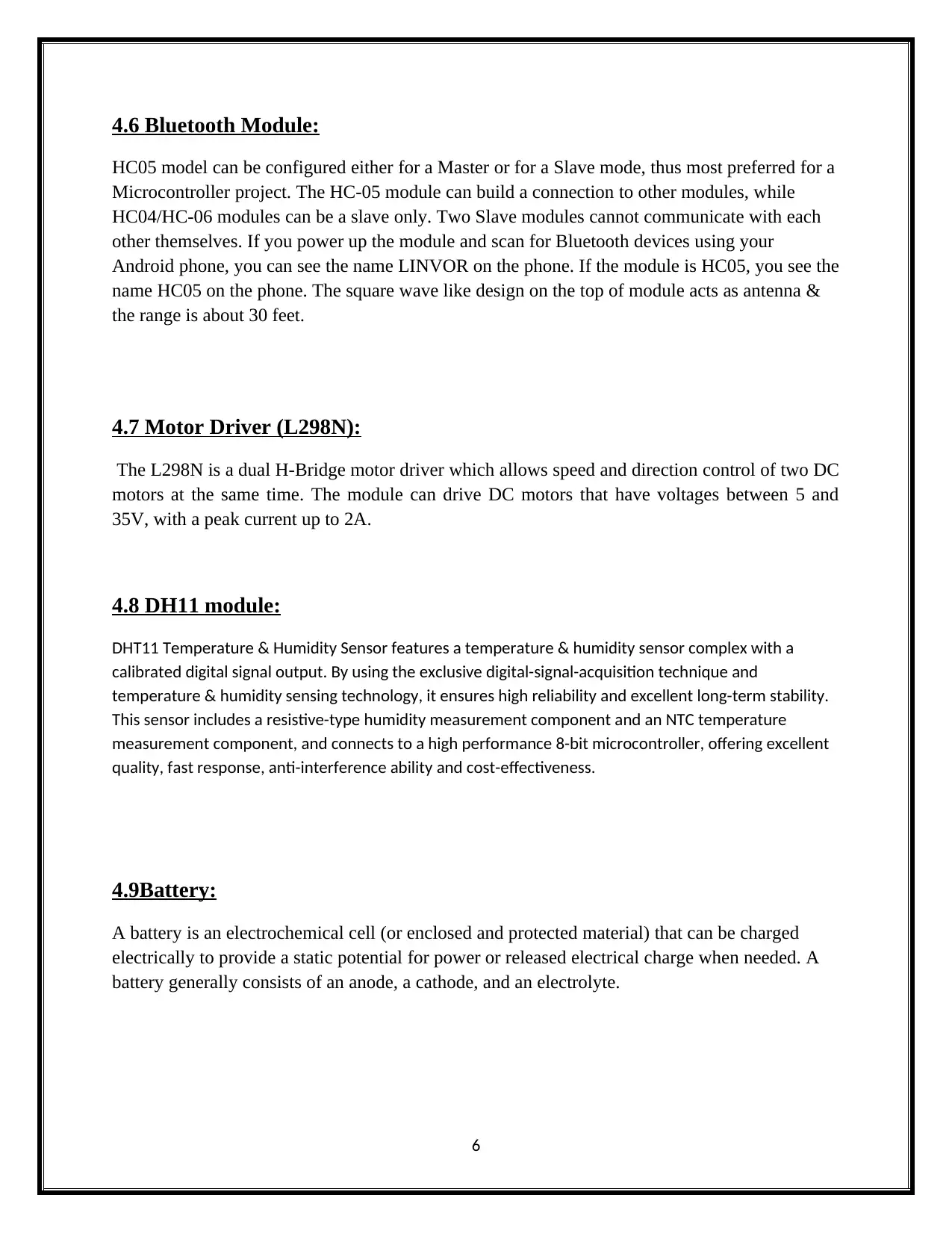
4.6 Bluetooth Module:
HC05 model can be configured either for a Master or for a Slave mode, thus most preferred for a
Microcontroller project. The HC-05 module can build a connection to other modules, while
HC04/HC-06 modules can be a slave only. Two Slave modules cannot communicate with each
other themselves. If you power up the module and scan for Bluetooth devices using your
Android phone, you can see the name LINVOR on the phone. If the module is HC05, you see the
name HC05 on the phone. The square wave like design on the top of module acts as antenna &
the range is about 30 feet.
4.7 Motor Driver (L298N):
The L298N is a dual H-Bridge motor driver which allows speed and direction control of two DC
motors at the same time. The module can drive DC motors that have voltages between 5 and
35V, with a peak current up to 2A.
4.8 DH11 module:
DHT11 Temperature & Humidity Sensor features a temperature & humidity sensor complex with a
calibrated digital signal output. By using the exclusive digital-signal-acquisition technique and
temperature & humidity sensing technology, it ensures high reliability and excellent long-term stability.
This sensor includes a resistive-type humidity measurement component and an NTC temperature
measurement component, and connects to a high performance 8-bit microcontroller, offering excellent
quality, fast response, anti-interference ability and cost-effectiveness.
4.9Battery:
A battery is an electrochemical cell (or enclosed and protected material) that can be charged
electrically to provide a static potential for power or released electrical charge when needed. A
battery generally consists of an anode, a cathode, and an electrolyte.
6
HC05 model can be configured either for a Master or for a Slave mode, thus most preferred for a
Microcontroller project. The HC-05 module can build a connection to other modules, while
HC04/HC-06 modules can be a slave only. Two Slave modules cannot communicate with each
other themselves. If you power up the module and scan for Bluetooth devices using your
Android phone, you can see the name LINVOR on the phone. If the module is HC05, you see the
name HC05 on the phone. The square wave like design on the top of module acts as antenna &
the range is about 30 feet.
4.7 Motor Driver (L298N):
The L298N is a dual H-Bridge motor driver which allows speed and direction control of two DC
motors at the same time. The module can drive DC motors that have voltages between 5 and
35V, with a peak current up to 2A.
4.8 DH11 module:
DHT11 Temperature & Humidity Sensor features a temperature & humidity sensor complex with a
calibrated digital signal output. By using the exclusive digital-signal-acquisition technique and
temperature & humidity sensing technology, it ensures high reliability and excellent long-term stability.
This sensor includes a resistive-type humidity measurement component and an NTC temperature
measurement component, and connects to a high performance 8-bit microcontroller, offering excellent
quality, fast response, anti-interference ability and cost-effectiveness.
4.9Battery:
A battery is an electrochemical cell (or enclosed and protected material) that can be charged
electrically to provide a static potential for power or released electrical charge when needed. A
battery generally consists of an anode, a cathode, and an electrolyte.
6
⊘ This is a preview!⊘
Do you want full access?
Subscribe today to unlock all pages.

Trusted by 1+ million students worldwide
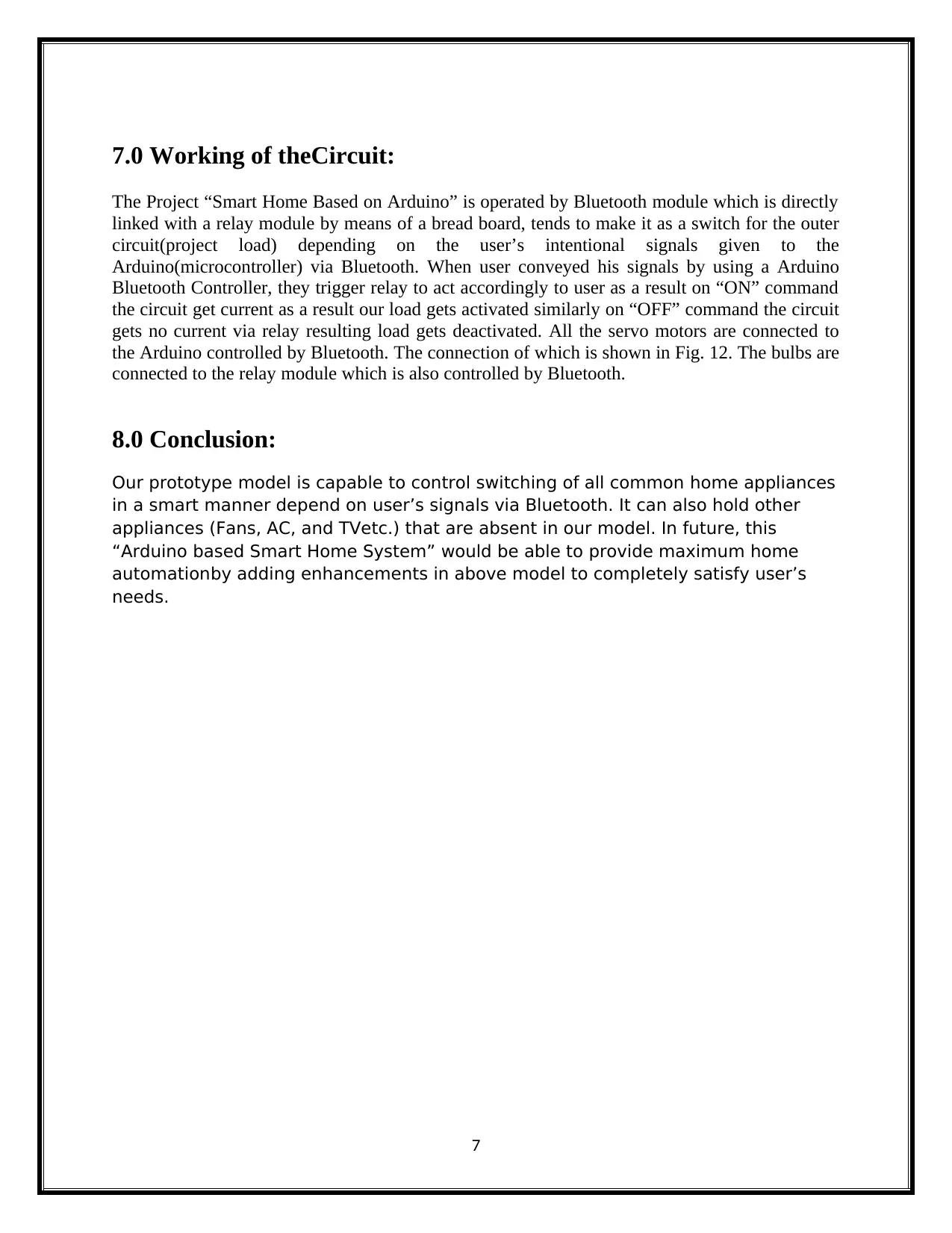
7.0 Working of theCircuit:
The Project “Smart Home Based on Arduino” is operated by Bluetooth module which is directly
linked with a relay module by means of a bread board, tends to make it as a switch for the outer
circuit(project load) depending on the user’s intentional signals given to the
Arduino(microcontroller) via Bluetooth. When user conveyed his signals by using a Arduino
Bluetooth Controller, they trigger relay to act accordingly to user as a result on “ON” command
the circuit get current as a result our load gets activated similarly on “OFF” command the circuit
gets no current via relay resulting load gets deactivated. All the servo motors are connected to
the Arduino controlled by Bluetooth. The connection of which is shown in Fig. 12. The bulbs are
connected to the relay module which is also controlled by Bluetooth.
8.0 Conclusion:
Our prototype model is capable to control switching of all common home appliances
in a smart manner depend on user’s signals via Bluetooth. It can also hold other
appliances (Fans, AC, and TVetc.) that are absent in our model. In future, this
“Arduino based Smart Home System” would be able to provide maximum home
automationby adding enhancements in above model to completely satisfy user’s
needs.
7
The Project “Smart Home Based on Arduino” is operated by Bluetooth module which is directly
linked with a relay module by means of a bread board, tends to make it as a switch for the outer
circuit(project load) depending on the user’s intentional signals given to the
Arduino(microcontroller) via Bluetooth. When user conveyed his signals by using a Arduino
Bluetooth Controller, they trigger relay to act accordingly to user as a result on “ON” command
the circuit get current as a result our load gets activated similarly on “OFF” command the circuit
gets no current via relay resulting load gets deactivated. All the servo motors are connected to
the Arduino controlled by Bluetooth. The connection of which is shown in Fig. 12. The bulbs are
connected to the relay module which is also controlled by Bluetooth.
8.0 Conclusion:
Our prototype model is capable to control switching of all common home appliances
in a smart manner depend on user’s signals via Bluetooth. It can also hold other
appliances (Fans, AC, and TVetc.) that are absent in our model. In future, this
“Arduino based Smart Home System” would be able to provide maximum home
automationby adding enhancements in above model to completely satisfy user’s
needs.
7
1 out of 7
Related Documents
Your All-in-One AI-Powered Toolkit for Academic Success.
+13062052269
info@desklib.com
Available 24*7 on WhatsApp / Email
![[object Object]](/_next/static/media/star-bottom.7253800d.svg)
Unlock your academic potential
Copyright © 2020–2025 A2Z Services. All Rights Reserved. Developed and managed by ZUCOL.





